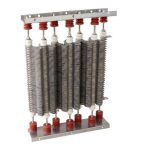Classification by voltammetric characteristics
For most conductors, at a certain temperature, their resistance remains almost constant and is a certain value, this type of resistance is called linear resistance. For some materials, the resistance varies significantly with current (or voltage), and the volt-ampere characteristic is a curve, which is called nonlinear resistance.
The ratio of voltage to current for a given voltage (or current) is the static resistance at that operating point, and the slope on the volt-ampere characteristic curve is the dynamic resistance. The way to express the characteristics of nonlinear resistance is complicated, but these nonlinear relationships are widely used in electronic circuits.
Classification by material
a. Wirewound resistors are made of resistive wire wound into resistors made of high resistance alloy wire wound on an insulating skeleton and coated with heat resistant glaze insulation layer or insulating paint.
Wirewound resistors have a low temperature coefficient, high resistance accuracy, good stability, heat and corrosion resistance, mainly used as precision high-power resistors, the disadvantage is poor high-frequency performance, large time constants.
b. Carbon synthetic resistors are made of carbon and synthetic plastic pressed into it.
c. Carbon film resistors are made by plating a layer of carbon on a porcelain tube and depositing crystalline carbon on a ceramic rod skeleton. Carbon film resistors are the most widely used resistors because of their low cost, stable performance, wide resistance range, and low temperature and voltage coefficients.
d. Metal film resistors are made by plating a layer of metal on a porcelain tube and vaporizing the alloy material on the surface of a ceramic rod skeleton by vacuum evaporation.

Metal film resistors have higher accuracy, better stability, noise, and smaller temperature coefficient than carbon film resistors. It is widely used in instrumentation and communication equipment.
e. Metal oxide film resistors are made by plating a layer of tin oxide on the porcelain tube and depositing a layer of metal oxide on the insulating rod. Since it is oxide itself, it is stable at high temperatures, heat shock resistant, and has high load capacity. By application, there are general purpose, precision, high frequency, high voltage, high resistance, high power and resistance networks.
Special Resistors
1, insurance resistors: also known as fusing resistors, under normal circumstances play a dual role of resistance and fuse, when the circuit fails and its power exceeds the rated power, it will melt like a fuse so that the connected circuit is disconnected. Fuse resistors are generally small resistance value (0.33





